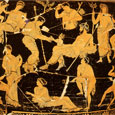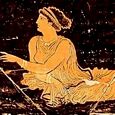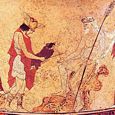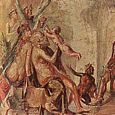NYSIADES
Greek Name
Νυσιας Νυσιαδες
Transliteration
Nysias, Nysiades
English Spelling
Nysiad, Nysiades
Translation
Of Mount Nysa
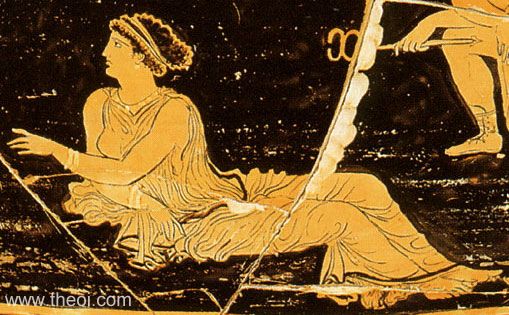
THE NYSIADES were, three, five or six Okeanid-nymphs of the mythical Mount Nysa. Zeus entrusted them with the care of the infant god Dionysos, alongside the elderly satyr Seilenos (Silenus). When the god was grown they joined his company as the first of the Bakkhantes (Bacchantes). Dionysos later set them amongst the stars as the constellation Hyades.
The Nysiades were closely identified with other nurses of the god Dionysos described in various rival traditions, such as the Hyades, Lamides, Nymphai Naxiai, Dodonides, Makris (Macris), and the daughters of Kadmos (Cadmus).
FAMILY OF THE NYSIADES
PARENTS
[1.1] OKEANOS (Orphic Hymn 51, Hyginus
Fabulae 182)
[2.1] Presumably NYSOS or SEILENOS, though nowhere stated
NAMES
[1.1] NYSA (Terpander Frag 9)
[1.2] NYSA, KISSEIS, BROMIS, ERATO, ERIPHIA, POLYHYMNO (Hyginus Fabulae
182)
[1.3] KISSEIS, BROMIE, KORONIS, AMBROSIE, ARSINOE (Hyginus Fabulae 182)
[1.4] KORONIS, AMBROSIA, PHYTO, POLYXO, EUDORA, PEDILE, THYONE (Hyginus Astronomica
2.21)
ENCYCLOPEDIA
NYSEIDES or NYSIADES (Nusiai), the nymphs of Nysa, who are said to have reared Dionysus, and whose names are Cisseïs, Nysa, Erato, Eriphia, Bromia, and Polyhymno. (Hygin. Fab. 182, Poet. Astr. ii. 21; Apollod. iii. 4. § 3 Ov. Met. iii. 314, Fast. iii. 769; Orph. Hymn. 50. 14; Schol. ad Hom. Il. xxiii. 486.)
NYSA (Nusa), a daughter of Aristaeus, who was believed to have brought up the infant god Dionysus, and from whom one of the many towns of the name of Nysa was believed to have derived its name. (Diod. iii. 69.)
BROME or BRO′MIE, one of the nymphs who brought up Dionysus on mount Nysa. (Hygin. Fab. 182; Serv. ad Virg. Eclog. vi. 15.)
Source: Dictionary of Greek and Roman Biography and Mythology.
ALTERNATE NAME SPELLINGS
Greek Name
Νυμφαι Νυσιαι
Transliteration
Nymphai Nysiai
Latin Spelling
Nymphae Nysiae
Translation
Nymphs of Mt Nysa
CLASSICAL LITERATURE QUOTES
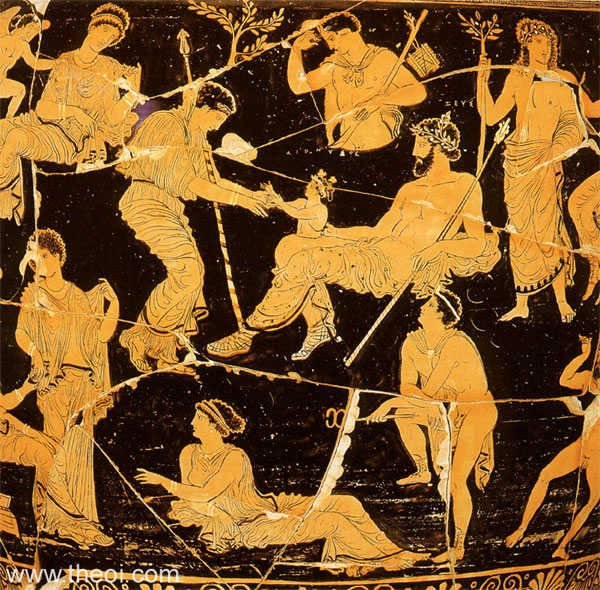
Homeric Hymn 26 to Dionysus 2 ff (trans. Evelyn-White) (Greek epic C7th to 4th B.C.)
:
"[Dionysos] splendid son of Zeus and glorious Semele. The rich-haired Nymphai (Nymphs) [i.e. the Nysiades]
received him in their bosoms from the lord his father and fostered and nurtured him carefully in the dells of
Nysa, where by the will of his father he grew up in a sweet-smelling cave, being reckoned among the immortals.
But when the goddesses had brought him up, a god oft hymned, then began he to wander continually through the
woody coombes, thickly wreathed with ivy and laurel. And the Nymphai followed in his train with him for their
leader; and the boundless forest was filled with their outcry."
Terpander, Fragment 9 (from Johannes Lydus, On the Months) (trans. Campbell, Vol.
Greek Lyric II) (C7th B.C.) :
"Terpander of Lesbos says Nyssa was the nurse of Dionysos."
Pseudo-Apollodorus, Bibliotheca 3. 29 (trans. Aldrich) (Greek mythographer C2nd A.D.)
:
"[Hera, upon learning that Dionysos had been fostered by Athamas, drove him mad :] As for Zeus, he escaped
Hera's anger by changing into a baby [Dionysos] goat. Hermes took him to the Nymphai (NYmphs) of Asian Nysa
[i.e. the Nysiades], whom Zeus in later times placed among the stars and named Hyades."
Diodorus Siculus, Library of History 4. 2. 3 (trans. Oldfather) (Greek historian
C1st B.C.) :
"Zeus taking up the child [i.e. Dionysos from the dead body of his mother Semele], handed it over to
Hermes, and ordered him to take it to the cave in Nysa, which lay between Phoinikia (Phoenicia) and the Neilos
(the River Nile), where he should deliver it to the Nymphai (Nymphs) that they should rear it and with great
solicitude bestow upon it the best of care. Consequently, since Dionysos was reared in Nysa, he received the
name he bears from Zeus (Dios) and Nysa. And Homer bears witness to this in his Hymns, whene he says :
‘There is a certain Nysa, mountain high, with forests thick, in Phoinike afar, close to Aigyptos'
(Egypt's) streams.’ After he had received his rearing by the Nymphai in Nysa, they say, he made the
discovery of wine and taught mankind how to cultivate the vine."
Plutarch, Life of Lysander 28. 4 (trans. Perrin) (Greek historian C1st to C2nd A.D.)
:
"[On Mount Kithairon (Cithaeron) in Boiotia is] the spring called Kissousa (Cissusa, Of the Ivy). Here, as
the story goes, his nurses [the Nysiades] bathed the infant Dionysos after his birth for the water has the color
and sparkle of wine, is clear, and very pleasant to the taste."
Orphic Hymn 51 to the Nymphs (trans. Taylor) (Greek hymns C3rd B.C. to 2nd A.D.)
:
"Nymphai (Nymphs) [i.e. Naiades], who from Okeanos (Oceanus) famed derive your birth, who dwell in liquid
caverns of the earth; nurses of Bakkhos (Bacchus) [Dionysos] . . . O Nysiai [Nysiades], insane
(manikoi), whom oaks delight, lovers of spring, Paionian virgins bright; with Bakkhos and with Deo
[Demeter] hear my prayer."
Orphic Hymn 30 to Dionysus :
"[Dionysos] listen gracious to my mystic prayer surrounded with thy choir of nurses [i.e. the Nysiades]
fair."
Orphic Hymn 53 to Amphietus :
"In graceful ring, thy nurses [i.e. the Nysiades] round thee [Dionysos] mystic anthems sing; when briskly
dancing with rejoicing powers, thou movest in concert with the circling hours."
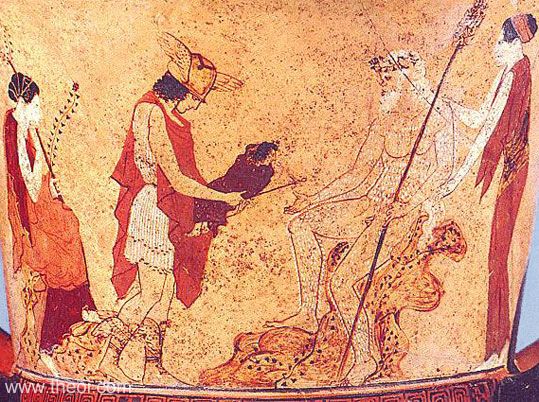
Pseudo-Hyginus, Fabulae 182 (trans. Grant) (Roman mythographer C2nd A.D.)
:
"Daughters of Oceanus . . . Their [the Nysiades] names are Cisseis, Nysa, Erato, Eriphia, Bromis,
Polyhymno. On Mount Nysa these obtained a boon from their foster-son, who made petition to Medea. Putting off
old age, they were changed to young girls, and later, consecrated among the stars, they are called Hyades.
Others report that they were called Arsinoe, Ambrosie, Bromie, Cisseis, and Coronis."
Pseudo-Hyginus, Fabulae 192 :
"Some say that since they are arranged in the form of the letter Upsilon they are called Hyades; some, they
are so called because they bring rain when they rise, for to rain is hyein in Greek. There are those
who think they are among the stars because they were the nurses of Father Liber [Dionysos] whom Lycurgus drove
out from the island Naxos." [N.B. The Nysiades are equated with the Hyades in this passage.]
Pseudo-Hyginus, Astronomica 2. 21 :
"It [the constellation Taurus] faces towards the East, and the stars which outline the face are called
Hyades. These, Pherecydes the Athenian [mythographer C5th B.C.] says, are the nurses of Liber [Dionysos], seven
in number, who earlier were Nymphae (Nymphs) called Dodonidae. Their names are as follows : Ambrosia, Eudora,
Pedile, Coronis, Polyxo, Phyto, and Thyone. They are said to have been put to flight by Lycurgus and all except
Ambrosia took refuge with Thetis, as Asclepiades [Greek poet C3rd B.C.] says.
But according to Pherecydes [mythographer C5th B.C.], they brought Liber to Thebes and delivered him to Ino, and
for this reason Jove [Zeus] expressed his thanks to them by putting them among the constellations."
Ovid, Metamorphoses 3. 14 ff (trans. Melville) (Roman epic C1st B.C. to C1st A.D.)
:
"Ino, his [Dionysos'] mother's sister, in secret from the cradle nursed the child [Dionysos] and brought
him up, and then the Nymphae (Nymphs) of Nysa were given his charge and kept him hidden away within their caves,
and nourished him on milk."
Ovid, Metamorphoses 3. 312 ff :
"From her [Semele's] womb her baby [Dionysos], still not fully formed, was snatched, and sewn (could one
believe the tale) inside his father's [Zeus'] thigh, and so completed there his mother's time. Ino, his mother's
sister, in secret from the cradle nursed the child and brought him up, and then the Nymphae Nyseides (Nysiad
Nymphs) were given his charge and kept him hidden away within their caves, and nourished him on milk. Down on
earth as destiny ordained these things took place, and Bacchus [Dionysos], baby twice born, was cradled safe and
sound."
Ovid, Metamorphoses 7. 294 ff :
"[The witch Medea rejuvenates Jason's father Aeson :] Liber [Dionysos] had seen from heaven this miracle,
so marvellous, and, learning that his own Nurses [i.e. the Nysiades] could have their youth restored, obtained
that boon and blessing from the Colchian [Medea]."
Ovid, Fasti 3. 767 ff (trans.Boyle) (Roman poetry C1st B.C. to C1st A.D.)
:
"Bacchus [Dionysos] loves the ivy most. Why this, too, is so, takes no time to learn. They say that, when
his stepmother [Hera] hunted for the boy, Nymphae (Nymphs) from Nysa screened the crib with its leaves"
Ovid, Fasti 5. 164 ff :
"To some they [the constellation Hyades] were the nurses of Bacchus [Dionysos], to others [they were
daughters of Atlas and sisters of Hyas]."
NAMES OF THE NYSIADES
Greek Name
Νυσα
Κισσεις
Βρομις Βρομιη
Κορωνις
Transliteration
Nysa
Kisseis
Bromis, Bromiê
Korônis
Latin Spelling
Nysa
Cisseis
Bromis, Bromia
Coronis
Translation
Of Mount Nysa
Of the Ivy
Loud Bacchic Cry
Arching (Neck)
Greek Name
Αμβροσια
Φυτω
Πολυξω
Ευδωρη
Transliteration
Ambrosia
Phytô
Polyxô
Eudôrê
Latin Spelling
Ambrosia
Phyto
Polyxo
Eudora
Translation
Of the Fruit-Drink
Of Vine Plantings
Of the Thick Woods
Well-Gifted
Greek Name
Πεδιλη
Εριφια
Πολυμνω
Ερατω
Αρσινοη
Transliteration
Pedilê
Eriphia
Polymnô
Eratô
Arsinoê
Latin Spelling
Pedila
Eriphia
Polyhymno
Erato
Arsinoe
Translation
Sandalled
Of the Goat-Kid
Of Many Hymns
Lovely, Beloved
Knowing Distillation
ANCIENT GREEK & ROMAN ART
SOURCES
GREEK
- The Homeric Hymns - Greek Epic C8th - 4th B.C.
- Greek Lyric I Terpander, Fragments - Greek Lyric C7th B.C.
- Apollodorus, The Library - Greek Mythography C2nd A.D.
- Diodorus Siculus, The Library of History - Greek History C1st B.C.
- Plutarch, Lives - Greek Historian C1st - 2nd A.D.
- The Orphic Hymns - Greek Hymns C3rd B.C. - C2nd A.D.
ROMAN
- Hyginus, Fabulae - Latin Mythography C2nd A.D.
- Hyginus, Astronomica - Latin Mythography C2nd A.D.
- Ovid, Metamorphoses - Latin Epic C1st B.C. - C1st A.D.
- Ovid, Fasti - Latin Poetry C1st B.C. - C1st A.D.
OTHER SOURCES
Other references not currently quoted here: Servius on Vergil's Aeneid 748 & Georgics 1.138, Eustathius on Homer's Iliad 1155.
BIBLIOGRAPHY
A complete bibliography of the translations quoted on this page.
